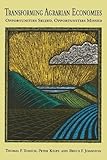Transforming Agrarian Economies : Opportunities Seized, Opportunities Missed / Peter Kilby, Thomas P. Tomich, Bruce F. Johnston.
Material type: TextPublisher: Ithaca, NY : Cornell University Press, [2018]Copyright date: ©1995Description: 1 online resource (496 p.)Content type:
TextPublisher: Ithaca, NY : Cornell University Press, [2018]Copyright date: ©1995Description: 1 online resource (496 p.)Content type: - 9781501717499
- 338.1/09172/4
- HD1417.T66 1995
- online - DeGruyter
| Item type | Current library | Call number | URL | Status | Notes | Barcode | |
|---|---|---|---|---|---|---|---|
 eBook
eBook
|
Biblioteca "Angelicum" Pont. Univ. S.Tommaso d'Aquino Nuvola online | online - DeGruyter (Browse shelf(Opens below)) | Online access | Not for loan (Accesso limitato) | Accesso per gli utenti autorizzati / Access for authorized users | (dgr)9781501717499 |
Frontmatter -- CONTENTS -- LIST OF BOXES -- PREFACE -- ACKNOWLEDGMENTS -- INTRODUCTION -- Part 1: The Rural Economy in the Development Process -- CHAPTER ONE. POVERTY AND THE RURAL ECONOMY -- CHAPTER TWO. STRUCTURAL TRANSFORMATION -- CHAPTER THREE. JAPAN, THE UNITED STATES, AND STRUCTURAL TRANSFORMATION -- PART TWO: FROM STRUCTURE TO STRATEGY -- CHAPTER FOUR. SMALL FARMS IN A BROAD-BASED AGRICULTURAL STRATEGY -- CHAPTER FIVE. AGRICULTURAL STRATEGIES AND AGRARIAN STRUCTURE -- CHAPTER SIX. LINKS BETWEEN AGRICULTURE AND INDUSTRY -- CHAPTER SEVEN. FERTILIZER PRODUCTION: STRATEGIC PITFALL? -- CHAPTER EIGHT. FISCAL BALANCE AND SOCIAL PROGRAM PRIORITIES -- PART THREE: CHOICES AND CONSEQUENCES -- CHAPTER NINE. CHINA AND THE SOVIET UNION -- CHAPTER TEN. TAIWAN AND MEXICO -- CHAPTER ELEVEN. KENYA AND TANZANIA -- CHAPTER TWELVE. GETTING PRIORITIES RIGHT -- REFERENCES -- INDEX OF NAMES -- INDEX OF SUBJECTS
restricted access online access with authorization star
http://purl.org/coar/access_right/c_16ec
The world's 58 poorest countries are diverse in many respects, but they share the characteristic of a labor force overwhelmingly dependent on agriculture. Challenging the assumption that mass poverty and chronic hunger are insoluble problems, this book systematically explores the multiple aspects of economic development in these countries, which are home to 60 percent of the world's population.The authors offer a broad-based development strategy to raise incomes through agricultural productivity growth and expanded rural employment. They present rich new information on the rural informal sector and on agriculture-industry interactions, and they analyze the impact of macroeconomic and social policies on the rural economy. Policy instruments aimed at bringing about broad-based development are carefully assessed from fiscal policy to development of hew seeds and farm implements.The book includes detailed case studies of countries that have seized—or missed—development opportunities. Comparison of the successful economic transformations of Japan and the United States shows how key ideas, which the authors call strategic notions, have enabled policymakers to act with foresight. Analyses of strategic choices in China, the Soviet Union, Taiwan, Mexico, Kenya, and Tanzania also show how development strategies that emerge from the real-world political economy reflect a mix of individual interests and strategic notions.
Mode of access: Internet via World Wide Web.
In English.
Description based on online resource; title from PDF title page (publisher's Web site, viewed 26. Apr 2024)


